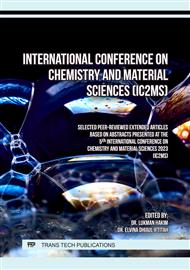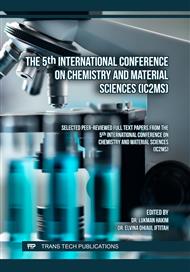[1]
S. Mashari, R. Nurmalina, and Suharno, "Indonesia Di Pasar Internasional," J. Agribisnis Indones., vol. 7, no. 1, p.37–52, 2019.
DOI: 10.29244/jai.2019.7.1.37-52
Google Scholar
[2]
C. D. H. Pratiwi, B. Busroni, and A. Sjaifullah, "Modifikasi Kitin Hasil Isolasi Autolisis Dari Limbah Udang Putih (Litopenaeus vannamei) Dengan Anhidrida Maleat," Berk. Sainstek, vol. 8, no. 2, p.46, 2020.
DOI: 10.19184/bst.v8i2.14223
Google Scholar
[3]
A. Alifatul, Z. Rohmah, A. Nur, A. Fajrin, and S. Gunawan, "Jurnal 07 ITS," vol. 2, no. 2, p.120–136, 2022.
Google Scholar
[4]
J. Chakravarty and T. A. Edwards, "Innovation from waste with biomass-derived chitin and chitosan as green and sustainable polymer: A review," Energy Nexus, vol. 8, no. September, 2022.
DOI: 10.1016/j.nexus.2022.100149
Google Scholar
[5]
I. Younes and M. Rinaudo, "Chitin and chitosan preparation from marine sources. Structure, properties and applications," Mar. Drugs, vol. 13, no. 3, p.1133–1174, 2015.
DOI: 10.3390/md13031133
Google Scholar
[6]
A. Sjaifullah and A. B. Santoso, "Autolytic Isolation of Chitin from White Shrimp (Penaues Vannamei) Waste," Procedia Chem., vol. 18, no. Mcls 2015, p.49–52, 2016.
DOI: 10.1016/j.proche.2016.01.009
Google Scholar
[7]
K. N. Nainggolan, "Ekstraksi Enzimatik Kitin dan Kitosandari Limbah Udang," vol. 4, no. 1, p.50–71, 2023.
Google Scholar
[8]
A. B. Pati and C. Winarti, "Daftar Pustaka Harris," vol. 31, no. 3, 2012.
Google Scholar
[9]
A. Ridhay, "PENGARUH WAKTU PROSES DEASETILASI KITIN DARI CANGKANG BEKICOT (Achatina fulica) TERHADAP DERAJAT DEASETILASI [EFFECT OF CHITIN DEACETYLATION PROCESSING TIMES FROM SHELLS OF SNAILS (Achatina fulica) TO DEGREE OF DEACETYLATION]," Kovalen, vol. 2, no. 1, p.1–7, 2016.
DOI: 10.22487/j24775398.2016.v2.i1.6039
Google Scholar
[10]
A. Purwanti and M. Yusuf, "Evaluasi Proses Pengolahan Limbah Kulit Udang Untuk Meningkatkan Mutu Kitosan Yang Dihasilkan," J. Teknol., vol. 7, no. 1, p.83–90, 2014.
Google Scholar
[11]
E. R. Safitra and R. Budhijanto, "Optimasi dan Pemodelan Matematis Deasetilasi Kitin Menjadi Kitosan Menggunakan KOH," vol. 9, no. 1, p.16–21, 2015.
Google Scholar
[12]
L. Ode, A. Nur, U. H. Oleo, C. L. Radiman, D. Wahyuningrum, and V. Suendo, "Deasetilasi Kitin secara Bertahap dan Pengaruhnya terhadap Derajat Deasetilasi serta Massa molekul Kitosan," J. Kim. Indones., vol. 5, no. January, p.17–21, 2010.
DOI: 10.22487/j24775398.2015.v1.i1.5161
Google Scholar
[13]
E. Saputra, W. Tjahjaningsih, and A. A. Abdillah, "Application of edible film from chitosan as biodegradable packaging," IOP Conf. Ser. Earth Environ. Sci., vol. 679, no. 1, 2021.
DOI: 10.1088/1755-1315/679/1/012071
Google Scholar
[14]
I. Sofia, H. Murdiningsih, and N. Yanti, "Pembuatan Dan Kajian Sifat-Sifat Fisikokimia, Mekanikal, Dan Fungsional Edible Film Dari Kitosan Udang Windu," J. Bahan Alam Terbarukan, vol. 5, no. 2, p.54–60, 2017.
DOI: 10.15294/jbat.v5i2.6364
Google Scholar
[15]
C. U. Seo et al., "Fabrication of polyaniline–carbon nano composite for application in sensitive flexible acid sensor," J. Ind. Eng. Chem., vol. 64, p.97–101, 2018.
DOI: 10.1016/j.jiec.2018.03.031
Google Scholar
[16]
S. U. Rahman, S. Bilal, and A. U. H. Ali Shah, "Synthesis and characterization of polyaniline-chitosan patches with enhanced stability in physiological conditions," Polymers (Basel)., vol. 12, no. 12, p.1–13, 2020.
DOI: 10.3390/polym12122870
Google Scholar
[17]
B. T. E. Thornton, A. Harrison, A. L. Pham, C. E. Castano, and C. Tang, "Polyaniline-Functionalized Nanofibers for Colorimetric Detection of HCl Vapor," ACS Omega, vol. 3, no. 3, p.3587–3591, 2018.
DOI: 10.1021/acsomega.8b00054
Google Scholar
[18]
D. Setijawati et al., "Pengaruh Derajat Deasetilasi Kitosan Dengan Perlakuan," J. Fish. Mar. Res., vol. 5, no. 2, p.276–285, 2021.
Google Scholar
[19]
D. Silvia, A. N. N. Ishaaq, and W. Prastiwinarti, "Label cerdas berbasis ekstrak kubis merah (Brassica oleracea) sebagai indikator kesegaran filet ikan tuna (Thunnus sp) pada suhu 4oC," J. FishtecH, vol. 10, no. 2, p.86–94, 2021.
DOI: 10.36706/fishtech.v11i1.15118
Google Scholar
[20]
E. Pasaribu, T. Nurhayati, and M. Nurilmala, "Extraction and Characterization of Pepsin Enzyme from Tuna (Thunnus albacares) Gastric," J. Pengolah. Has. Perikan. Indones., vol. 21, no. 3, p.486, 2018.
DOI: 10.17844/jphpi.v21i3.24727
Google Scholar
[21]
Mursida, Tasir, and Sahriawati, "Efektifitas Larutan Alkali pada Proses Deasetilasi," Jphpi, vol. 21, no. 2, p.356–366, 2018.
DOI: 10.17844/jphpi.v21i2.23091
Google Scholar
[22]
Q. Pristiwani, "UJI TOKSISITAS KITOSAN CANGKANG KEPITING RAJUNGAN (Portunus pelagicus) DAN KEPITING BAKAU (Scylla serrata) DENGAN METODE BRINE SHIRMP LETHALITY TEST (BSLT)," Cross-border, vol. 6, no. 2, p.862–878, 2023.
DOI: 10.26753/jfks.v2i2.984
Google Scholar
[23]
D. Setijawati et al., "Pengaruh Derajad Deasetilasi Chitosan dengan Perlakuan Alkali Berbeda Terhadap Kualitas Edible Film," JFMR-Journal Fish. Mar. Res., vol. 5, no. 2, 2021.
DOI: 10.21776/ub.jfmr.2021.005.02.13
Google Scholar
[24]
J. M. F. Pavoni, C. L. Luchese, and I. C. Tessaro, "Impact of acid type for chitosan dissolution on the characteristics and biodegradability of cornstarch/chitosan based films," Int. J. Biol. Macromol., vol. 138, p.693–703, 2019.
DOI: 10.1016/j.ijbiomac.2019.07.089
Google Scholar
[25]
B. Mohammadi, S. Pirsa, and M. Alizadeh, "Preparing chitosan–polyaniline nanocomposite film and examining its mechanical, electrical, and antimicrobial properties," Polym. Polym. Compos., vol. 27, no. 8, p.507–517, 2019.
DOI: 10.1177/0967391119851439
Google Scholar



